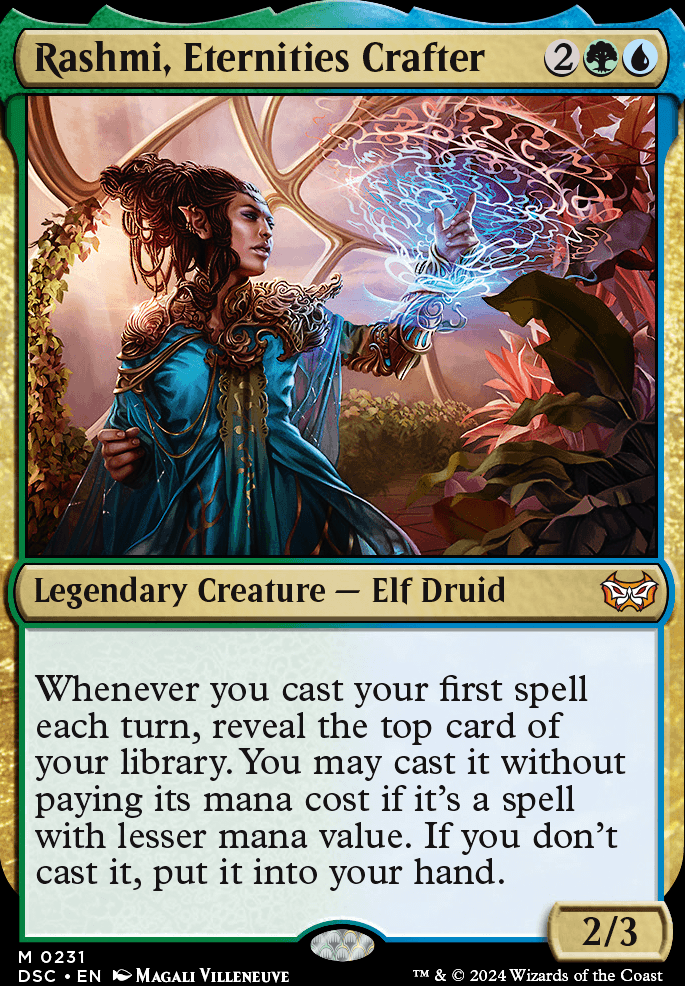Instant (40)
- 1x Beast Within
- 1x Blue Sun's Zenith
- 1x Brainstorm
- 1x Chain of Vapor
- 1x Counterspell
- 1x Cyclonic Rift
- 1x Dig Through Time
- 1x Dispel
- 1x Disrupt
- 1x Dramatic Reversal
- 1x Fact or Fiction
- 1x Fierce Guardianship
-
1x
Flusterstorm

- 1x Force of Negation
- 1x Force of Will
- 1x Growth Spiral
- 1x Impulse
- 1x Into the Roil
- 1x Mana Drain
- 1x Mana Leak
- 1x Mental Misstep
- 1x Muddle the Mixture
- 1x Mystical Tutor
- 1x Natural State
- 1x Nature's Claim
- 1x Negate
-
1x
Nexus of Fate
 *list*
*list*
- 1x Noxious Revival
- 1x Opt
- 1x Pact of Negation
- 1x Pongify
- 1x Pull from Tomorrow
- 1x Rapid Hybridization
- 1x Reality Shift
- 1x Reap
- 1x Spell Snare
- 1x Submerge
- 1x Swan Song
- 1x Thought Scour
- 1x Veil of Summer
Land (30)
- 1x Ancient Tomb
-
1x
Breeding Pool

- 1x Command Tower
- 1x Flooded Grove
- 1x Flooded Strand
- 2x Forest
- 12x Island
- 1x Misty Rainforest
- 1x Mystic Sanctuary
- 1x Polluted Delta
- 1x Prismatic Vista
- 1x Scalding Tarn
- 1x Tropical Island
- 1x Verdant Catacombs
- 1x Waterlogged Grove
- 1x Windswept Heath
- 1x Wooded Foothills
- 1x Yavimaya Coast
Enchantment (7)
- 1x Back to Basics
- 1x Carpet of Flowers
- 1x Mystic Remora
- 1x Rhystic Study
- 1x Sylvan Library
- 1x Utopia Sprawl
- 1x Wild Growth
Creature (4)
Commander (1)
Artifact (12)
- 1x Arcane Signet
- 1x Chrome Mox
- 1x Cursed Totem
- 1x Grafdigger's Cage
- 1x Isochron Scepter
- 1x Mana Crypt
- 1x Mana Vault
- 1x Mox Diamond
- 1x Sapphire Medallion
- 1x Sensei's Divining Top
- 1x Simic Signet
- 1x Sol Ring
Sorcery (6)
Suggestions
Updates Add
Comments
Attention! Complete Comment Tutorial! This annoying message will go away once you do!
Important! Formatting tips — Comment Tutorial — markdown syntax
Please login to comment
| Date added | 4 years |
| Last updated | 4 years |
| Exclude colors | WBR |
| Legality | This deck is not Commander / EDH legal. |
| Rarity (main - side) | 8 - 0 Mythic Rares 37 - 0 Rares 18 - 0 Uncommons 23 - 0 Commons |
| Cards | 100 |
| Avg. CMC | 2.10 |
| Tokens | Ape 3/3 G, Beast 3/3 G, Bird 2/2 U, Frog Lizard 3/3 G, Manifest 2/2 C |
| Votes | |
| Ignored suggestions | |
| Shared with | |
| Views |

